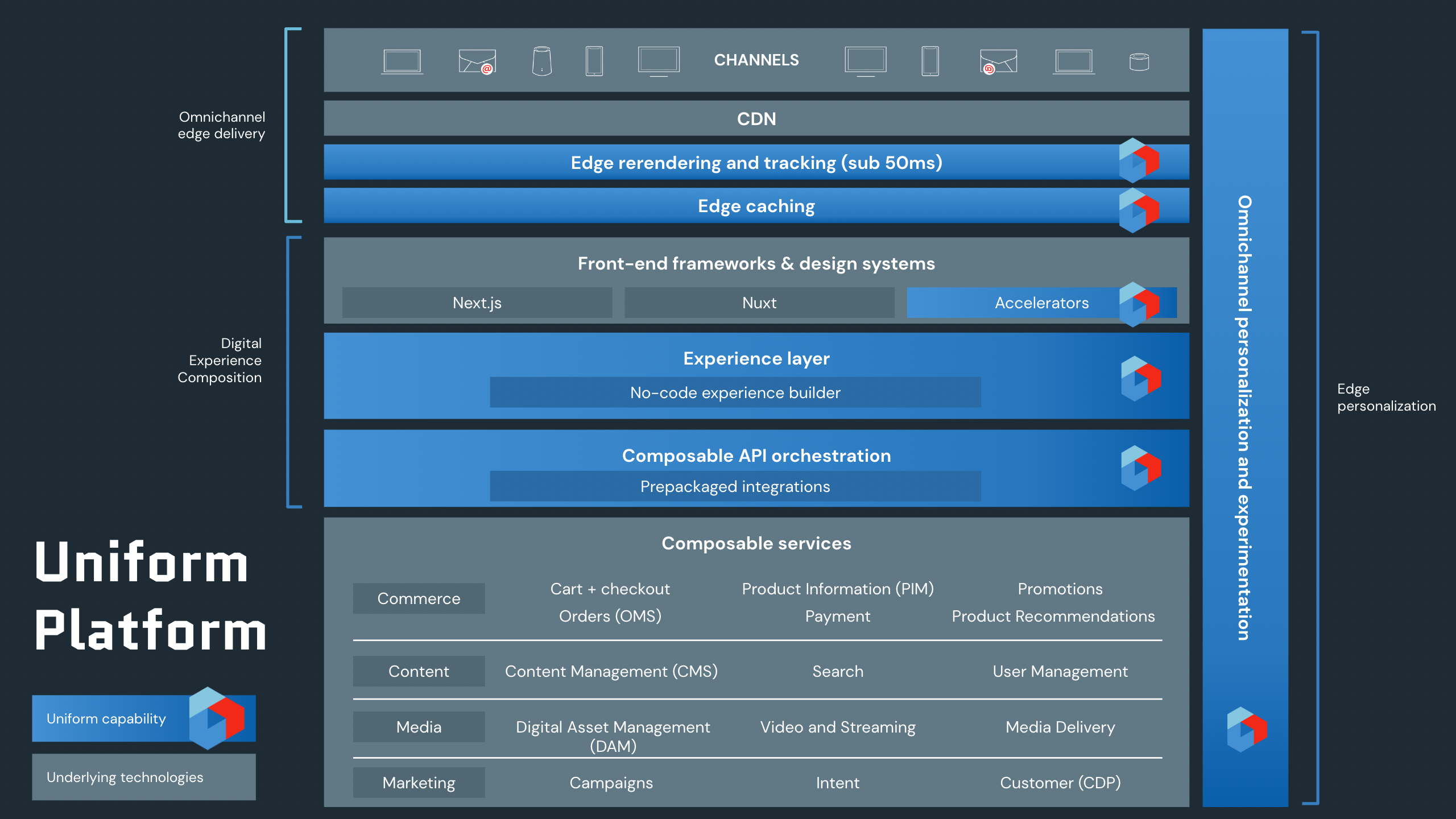Uniform blog/What is digital experience composition and why should marketers care?
What is digital experience composition and why should marketers care?
What is digital experience composition and why should marketers care?
In recent years, a new model called composable architectures has emerged for building digital experiences, with headless, API-first services like CMS, commerce, or DAM, which developers then connect together to spur digital experiences. Developers or technical teams that have replatformed your martech stack might well be familiar with such a model.
By eliminating the need to buy a suite of unnecessary software, composable architectures are much more flexible and efficient, offering developers many advantages. For marketers and business users, however, the benefits come with a steep price. It now suddenly requires several tools to perform tasks that used to be easy, and even publishing simple pages or making basic changes would require support from developers, slowing down both teams. As a result, the company is on the back foot, unable to respond to market conditions, technological innovations, or changes in customer behavior as quickly as rivals.
To become mainstream, composable architectures must empower business teams to work independently and maintain control over digital experiences while retaining (or even improving) the technical and cost benefits for developers. Tools that address those dual challenges of usability and integration have started to emerge, notably a new category that has been coined by Gartner: digital experience composition.

Making composable productive for business users
Composable architectures comprise different best-of-need products that serve a single purpose. Business-class websites and apps cannot run on content alone so, in addition to a headless CMS, composable services like commerce for product information, shopping-cart features, and DAM for video and images are also required. Of course, those services must work together, but they all come from different vendors and don’t connect automatically out of the box.
For marketers, this scenario creates issues around productivity and control. Given the technical complexity, they might not know which composable service holds what data or might need to log in to multiple tools to make edits. Launching a page often means submitting an IT ticket and waiting.
Since a digital experience composition platform (DXCP) makes it easy for composable services to work together, businesses can build an experience layer through which marketers, merchandisers, and other business users can create digital experiences with no-code tools without worrying about how the composable services in the back end are connected. All that translates to significant time savings for marketing teams as they launch engaging experiences, and for developers, too, who would save the hundreds of hours of coding it can take to manually integrate services while setting up a new martech stack.
To show how DXCP affects your day-to-day work, consider the process of building a Product Detail Page. You need information from the commerce platform to add a product carousel, detailed product images from a DAM, and links to articles in the CMS to show potential customers how to use the product. In a traditional composable model, you’d need to work in at least three different systems and retain the context throughout. To change any formatting, you must submit an IT ticket and wait.
In contrast, DXCP gives you a clear outline of the page with slots into which to place the content and control of the front-end components. That means marketers can quickly bring in what they need to build a seamless experience by assembling prebuilt components and then deliver it to the appropriate channels.
As Gartner explains, digital experience composition is “emerging to handle digital multiexperience orchestration in a ‘headless,’ decoupled, composable world,” adding that “these tools allow developers to set up digital experiences and hand them to business users for day-to-day management in no-code environments.”
Building experiences is different from building pages
Page builders are tools with which small teams create well-crafted, one-off pages by simply dragging and dropping components and quickly changing the visual style. Those tools are suited for minor use cases with simple designs, whose elements and layout you can create easily.
In contrast, experience builders like Uniform cover a much wider scope: pages, apps, and omnichannel experiences. Uniform manages content at scale, enabling reuse of aggregated content, publication to multiple channels, and smooth team collaboration with a UI that focuses on findability and reuse. Below are Uniform’s major tasks.
- Orchestrate composable tools.
- Personalize digital experiences.
- Enable advanced API connections.
- Create omnichannel experiences.
- Enhance content through automation.
- Perform A/B testing to raise conversion rates.
DXCP makes it easy for marketers to build composable experiences
In recent years, companies have been increasingly transitioning to composable solutions based on headless CMS and other API-first services. And for good reason: higher performance, lower costs, cutting-edge capabilities, and, most important, an ability to pick and choose the right tools for the business’s unique needs.
However, for many companies implementing composable for the first time, those benefits have become broken promises as the marketing team finds itself losing control over its most important assets. For composable architectures to work for most businesses, marketers must be able to launch and build cutting-edge digital experiences fast, as well as focus on creation and iteration, while developers own the back-end infrastructure.

Uniform DXCP does just that with a powerful no-code experience builder for omnichannel experiences and high-performance, edge-based personalization for a captivating CX, more conversions, and higher SEO ranking. If you’re looking to take control of your stack and empower marketing teams, contact us for a demo.
More about digital experience composition

Unlocking the promise of composability
The key to composability!





